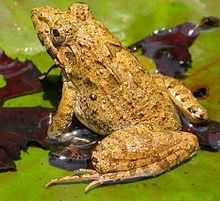Hoplobatrachus tigerinus
| Hoplobatrachus tigerinus | |
|---|---|
 | |
| Indian bullfrog from the Western Ghats | |
| Conservation status | |
| Scientific classification | |
| Kingdom: | Animalia |
| Phylum: | Chordata |
| Class: | "Amphibia" (wide sense) |
| Order: | Anura |
| Family: | Dicroglossidae |
| Genus: | Hoplobatrachus |
| Species: | H. tigerinus |
| Binomial name | |
| Hoplobatrachus tigerinus (Daudin, 1803) | |
| Synonyms | |
|
Rana tigerina | |
Hoplobatrachus tigerinus, the Indus Valley bullfrog or Indian bullfrog, popular name Asian bullfrog, Asean bullfrog or Asia bullfrog, is a large species of frog found in Myanmar, Bangladesh, India, Pakistan, Afghanistan, and Nepal.[1]
Description

Vomerine teeth in two strong oblique series commencing from the inner anterior angle of the choanae; lower jaw with two not very prominent bony processes in front. Head moderate; Snout more or less pointed; canthus rostralis obtuse; nostril a little nearer to the end of the mouth than to the eye; interorbital space narrower than the upper eyelid; tympanum distinct, about two thirds the size of the eye. Fingers rather short, first extending beyond second; toes moderate, obtuse, nearly entirely webbed ; a much developed membranaceous fringe along the fifth toe; sub-articular tubercles moderate; inner metatarsal tubercle very variable, small and blunt, or (var. ceylanica, Ceylon and S. India) nearly as long as the inner toe, strongly compressed, crescent shaped, shovel-shaped; no outer tubercle, a tarsal fold. Tibio-tarsal articulation reaching the ear, the eye, or a little beyond. Skin of back with longitudinal folds; a strong fold above the tympanum. Green or olive above, with dark spots; often a light vertebral line. Male with two subgular vocal sacs, conspicuous externally by folds of the skin on the sides of the throat; these regions generally blackish.[2]
It is essentially aquatic, and is said, to jump over the surface of the water much in the same way as on land when frightened,.[2]
From snout to vent 6.5 inches.
This species is classified as Least Concern in the IUCN red list.[1]
Cultivation
Captive farming of this species as a food source, and also of the American bullfrog (Rana catesbeiana), started in Thailand in the 1990s.[3]
References
- ↑ 1.0 1.1 1.2 Anand Padhye, Kelum Manamendra-Arachchi, Anslem de Silva, Sushil Dutta, Tej Kumar Shrestha, Sabitry Bordoloi, Theodore Papenfuss, Steven Anderson, Sergius Kuzmin, Muhammad Sharif Khan & Ronald Nussbaum (2008). "Hoplobatrachus tigerinus". IUCN Red List of Threatened Species. Version 2009.2. International Union for Conservation of Nature. Retrieved February 3, 2010.
- ↑ 2.0 2.1 Boulenger, G. A. (1890). Fauna of British India. Reptilia and Batrachia.
- ↑ Flores Nava, A. (2005). "Rana catesbeiana". Cultured Aquatic Species Information Programme. FAO Fisheries and Aquaculture Department. Retrieved 13 December 2012.
